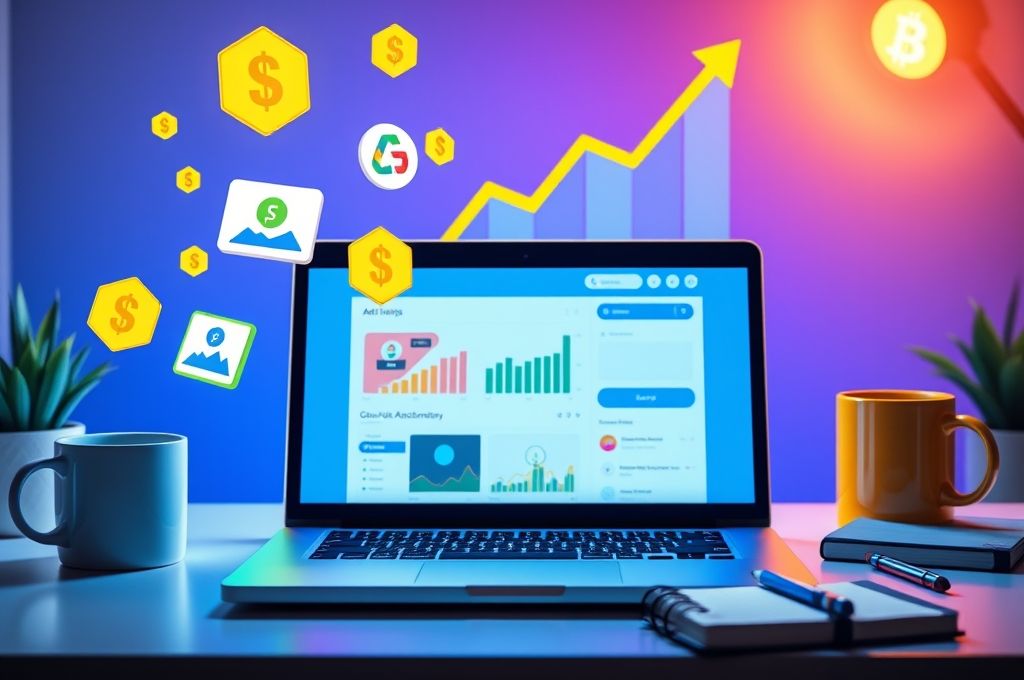Introduction
Imagine waking up one morning and checking your email to find a notification: “You’ve earned $500 from your blog this month.” No boss, no commute, just passive income flowing in from content you created months ago. Sounds like a dream? For thousands of bloggers around the world, it’s very much a reality—and Google AdSense is the engine behind it.
In today’s digital age, turning your passion into profit has never been more accessible. Whether you love writing about travel, cooking, tech, or personal finance, your blog can become a source of real income. And one of the simplest, most trusted ways to monetize your content? Google AdSense.
This article will walk you through exactly how to make money with Google AdSense on your blog—step by step. From setting up your site and creating high-quality content, to getting approved for AdSense and maximizing your earnings, we’ll cover everything you need to know. You don’t need to be a tech expert or a full-time blogger. With consistency, strategy, and a bit of patience, you can start earning from your blog sooner than you think.
Let’s dive in and turn your words into wealth.
1. Why Google AdSense Is Still the Best Choice for Blog Monetization
When it comes to making money online, there are countless options: affiliate marketing, selling digital products, YouTube ads, sponsorships—the list goes on. So why focus on Google AdSense?
First, AdSense is beginner-friendly. Unlike other monetization methods that require building an audience or negotiating with brands, AdSense works right out of the gate. Once approved, Google automatically places ads on your site based on your content and audience.
Second, it’s trustworthy and reliable. Google is one of the most respected names in tech, and AdSense has been around since 2003. Millions of websites use it, and payments are made on time every month—usually via direct deposit or check.
Third, it scales with your traffic. The more people visit your blog, the more ad impressions you generate, and the higher your earnings. Even if you’re just starting out, every page view counts.
And finally, it’s passive income at its finest. Once the ads are placed, they work 24/7. You can write a post today, and it could earn you money for years to come—especially if it ranks well in search engines.
But here’s the catch: AdSense doesn’t pay well per click unless you have quality traffic. A visitor from the U.S. clicking on an ad might earn you $0.20, while a click from another country might only bring $0.02. That’s why content, audience targeting, and SEO matter so much.
The good news? You don’t need millions of visitors to make a profit. Many bloggers earn $100–$500 per month with just 10,000 monthly page views. As your blog grows, so do your earnings—often exponentially.
So, if you’re serious about making money from your blog, AdSense is a solid foundation. But it all starts with one thing: a great blog.
2. Building a Blog That Attracts Advertisers and Earns Real Money
You can’t run ads on a blog that no one visits. So before you even think about AdSense, you need to build a blog that people actually want to read.
Start with your niche. Choose a topic you’re passionate about and that has an audience. Popular niches include:
- Personal finance
- Health & fitness
- Travel
- Parenting
- Technology
- Food & recipes
- Self-improvement
Why does your niche matter for AdSense? Because advertisers pay more to reach certain audiences. For example, a blog about credit cards or investing will attract high-paying financial ads, while a general lifestyle blog might get lower-paying ones.
Next, pick a domain name and hosting provider. Your domain (like yourblogname.com) should be short, memorable, and related to your niche. For hosting, platforms like Bluehost, SiteGround, or Hostinger are beginner-friendly and integrate easily with WordPress.
Once your site is live, design it for readability and trust. Use a clean theme, fast loading speed, and mobile-friendly layout. Google rewards sites that offer a good user experience—and so do your readers.
Now, the most important part: content. Your blog needs to provide real value. That means:
- Solving problems
- Answering questions
- Offering unique insights
- Being well-researched and original
For example, instead of writing “10 Tips for Weight Loss,” try “How I Lost 20 Pounds in 3 Months Without Dieting—And What Science Says.” That kind of headline attracts more clicks, ranks better in Google, and earns more from ads.
Remember: Google AdSense rewards quality. If your site is full of thin, copied, or misleading content, you’ll either get rejected or earn very little. But if you publish helpful, original articles consistently, you’re setting yourself up for long-term success.
3. Getting Approved for Google AdSense: The Step-by-Step Process
You’ve built your blog. You’ve published several high-quality posts. Now it’s time to apply for Google AdSense.
But here’s a hard truth: many bloggers get rejected on their first try. The reason? Google has strict quality guidelines to ensure ads appear on trustworthy sites.
So, what do you need to get approved?
First, your blog must have at least 10–15 original posts. These should be well-written, informative, and relevant to your niche. Avoid filler content or short articles under 500 words.
Second, your site needs essential pages:
- About Page – Who are you? Why should readers trust you?
- Contact Page – How can people reach you?
- Privacy Policy – Required by law and by Google.
- Disclaimer – Especially if you mention products or health advice.
Third, your site must be easy to navigate. Clear menus, internal links, and a search bar help users (and Google) find content quickly.
Fourth, avoid prohibited content. Google won’t approve sites with:
- Adult content
- Hate speech
- Copyrighted material
- Misinformation
- Excessive pop-ups or ads
Once you meet these requirements, go to adsense.google.com and sign up. You’ll need to:
- Enter your website URL
- Provide your personal or business information
- Wait for Google to review your site (usually 1–7 days)
During the review, Google checks for:
- Content quality
- Site structure
- User experience
- Compliance with policies
If approved, you’ll get an email and access to your AdSense dashboard. If rejected, don’t panic. Most rejections come with feedback. Fix the issues and reapply in a few weeks.
Pro tip: Apply only when you’re truly ready. Multiple rejections can hurt your chances. Take your time, improve your site, and try again.
4. Placing Ads Strategically: Where to Put Them for Maximum Earnings
Congratulations—you’re approved! Now it’s time to place ads on your blog.
But here’s the thing: not all ad placements are created equal. Where you put your ads can make a huge difference in your earnings.
Google AdSense offers several ad formats:
- Display ads (rectangles, banners)
- In-article ads (between paragraphs)
- In-feed ads (in blog post lists)
- Link units (text links)
- Anchor ads (bottom of screen)
- Vignette ads (full-screen on mobile)
So, where should you place them?
Best performing spots:
- Above the fold – The first thing readers see when they land on your page. A 728×90 or 300×250 ad here can get high visibility.
- Within the content – After the first or second paragraph. In-article ads blend naturally and get good engagement.
- After the headline – On mobile, this spot often performs well.
- Sidebar (if using desktop) – A 300×250 ad near the top of the sidebar works, but less effective on mobile.
- End of post – Readers who finish your article are highly engaged. Place a display ad or link unit here.
What to avoid:
- Too many ads (clutters the page and hurts user experience)
- Pop-ups or auto-playing videos
- Ads too close to navigation buttons
- Placing ads where they look like content (misleading)
Google also offers Auto Ads, which automatically place ads using AI. This can be great for beginners, but advanced users often get better results with manual placement.
Pro tip: Use heatmaps (like Hotjar or Crazy Egg) to see where users look and click. This helps you optimize ad positions over time.
Remember: user experience comes first. If your site feels like an ad farm, people will leave—and Google may penalize you. Balance is key.
5. Increasing Traffic = Increasing Earnings: SEO and Promotion Strategies
Here’s a simple truth: AdSense earnings depend on traffic. No traffic = no clicks = no income.
So how do you get more people to visit your blog?
The answer: SEO (Search Engine Optimization).
SEO helps your blog rank higher in Google, bringing in free, organic traffic every day. And the best part? That traffic can last for months or even years.
Here’s how to optimize your blog for SEO:
1. Do keyword research
Use tools like Google Keyword Planner, Ubersuggest, or AnswerThePublic to find what people are searching for in your niche. For example, instead of “healthy eating,” target “easy low-carb meals for beginners.”
2. Optimize your content
- Use your main keyword in the title, first paragraph, and headings
- Write detailed, long-form content (1,500+ words performs better)
- Add internal links to other posts on your blog
- Use external links to authoritative sources
- Include images with descriptive file names and alt text
3. Improve site speed
Use tools like Google PageSpeed Insights to check your loading time. Compress images, enable caching, and choose a fast host.
4. Get backlinks
Other websites linking to your blog boost your authority. Share your posts on social media, join niche forums, or guest post on related blogs.
5. Promote your content
Don’t just publish and pray. Share your posts on:
- Pinterest (great for food, DIY, parenting)
- Facebook Groups
- Reddit (in relevant communities)
- LinkedIn (for professional topics)
- Email newsletters
Bonus: Repurpose content. Turn a blog post into a YouTube video, Instagram carousel, or Twitter thread. More platforms = more traffic.
With consistent SEO and promotion, your traffic will grow—and so will your AdSense income.
6. Understanding AdSense Earnings: RPM, CTR, and How to Improve Them
You’ve got traffic. You’ve got ads. But how much are you actually earning?
Google AdSense doesn’t pay per visitor. It pays based on:
- Clicks (when someone clicks an ad)
- Impressions (when an ad is shown)
Two key metrics to track:
- CTR (Click-Through Rate): The percentage of people who see an ad and click it. Average CTR is 0.5%–1%.
- RPM (Revenue Per Mille): How much you earn per 1,000 page views. This is your real income metric.
For example, if your RPM is $10, you earn $10 for every 1,000 page views—regardless of clicks.
What affects RPM?
- Niche: Finance, insurance, and tech have high RPMs ($15–$30+). Lifestyle or entertainment may be lower ($2–$6).
- Traffic location: U.S., U.K., Canada, and Australia pay more.
- Content quality: In-depth, trustworthy content attracts better ads.
- Ad placement: Strategic spots increase visibility and clicks.
How to improve your RPM and CTR:
- Focus on high-paying niches or sub-niches
- Write detailed, long-form guides (e.g., “Best Credit Cards for Travel Rewards in 2024”)
- Use responsive ad units that fit all devices
- Test different ad formats and sizes
- Enable “Auto Ads” to let Google optimize placements
- Update old posts to keep them ranking and earning
Real example: A blogger writing about home insurance might earn $25 RPM, while a pet blog earns $3 RPM. That’s an 8x difference for similar traffic.
So, while traffic matters, niche and content quality matter more.
7. Avoiding Common AdSense Mistakes That Can Get You Banned
Google AdSense can be a goldmine—but it can also shut down overnight if you break the rules.
Here are the top mistakes that get bloggers banned:
1. Clicking your own ads (or asking others to)
This is the biggest no-no. Google tracks IP addresses and user behavior. Even “accidental” clicks can trigger warnings. Never, ever click your own ads.
2. Invalid traffic (bots, auto-refresh, incentivized clicks)
Using bots, refresh scripts, or offering rewards for clicks violates policy. Google will detect it and disable your account.
3. Placing too many ads above the fold
If users see more ads than content when they land, Google may penalize you. Follow the “one ad above the fold” rule.
4. Misleading ad placements
Don’t make ads look like content buttons (e.g., “Download Now” next to an ad). This confuses users and violates policies.
5. Using copyrighted images or content
Always use original or licensed content. Copying text or images can lead to takedowns or bans.
6. Promoting prohibited content
No adult material, hate speech, illegal activities, or dangerous misinformation.
What to do if you get a warning?
Don’t panic. Google usually sends an email with details. Fix the issue immediately and respond through your AdSense account. Most warnings can be resolved.
Best practice: Review Google’s AdSense Program Policies regularly. Stay compliant, and your account will stay safe.
8. Beyond AdSense: Growing Your Blog into a Full-Time Income
Here’s the truth: AdSense alone may not make you rich. Most bloggers earn a side income, not a full-time salary—unless they scale.
So how do you go from $100/month to $3,000/month or more?
Combine AdSense with other income streams:
- Affiliate marketing: Recommend products and earn commissions (e.g., Amazon, ShareASale).
- Digital products: Sell eBooks, courses, or printables.
- Sponsored posts: Partner with brands for paid content.
- Membership sites: Offer premium content for a fee.
- Email marketing: Build a list and promote offers directly.
For example, a travel blogger might:
- Earn $200/month from AdSense
- Make $500/month from affiliate links to travel gear
- Charge $1,000 for a sponsored post with a hotel brand
- Sell a $29 travel planning course
Suddenly, blogging becomes a real business.
Also, focus on scaling:
- Publish consistently (2–4 posts per week)
- Outsource writing or SEO if needed
- Reinvest earnings into better tools or ads
- Track analytics to double down on what works
Many full-time bloggers started with just a few hundred dollars from AdSense. But by diversifying and growing, they turned their blogs into six-figure businesses.
Conclusion
Making money with Google AdSense on your blog isn’t a get-rich-quick scheme—it’s a long-term strategy built on value, consistency, and smart decisions.
You’ve learned how to:
- Choose a profitable niche
- Build a professional blog
- Get approved for AdSense
- Place ads effectively
- Drive traffic with SEO
- Increase RPM and avoid bans
- Scale into a full-time income
The journey starts with one post. One idea. One decision to take action.
You don’t need millions of followers. You don’t need to be a tech genius. You just need to start, stay consistent, and keep improving.
So, what are you waiting for?
Pick your niche. Write your first post. Apply for AdSense. And start building the blog—and the income—of your dreams.
Now I’d love to hear from you: What’s the first topic you’d write about on your blog? Share it in the comments below—let’s inspire each other to create, grow, and earn! 💡

Danilo Ferreira is a passionate entrepreneur, travel, and financial freedom enthusiast, always seeking new ways to expand his horizons and live with purpose. Driven by a high-performance mindset, he combines discipline and curiosity to achieve ambitious goals, exploring the world while building projects that reflect his vision of independence and continuous growth.







